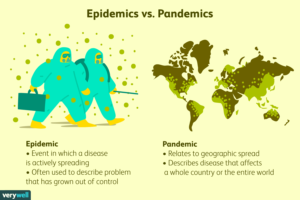
GS Paper III :- Disaster management.
What to study :-
- For Prelims : Details of the virus and its impact.
- For Mains :- Significance of the disease, challenges ahead and the measures needed to save human lives.
Context:
The coronavirus outbreak came to light when on December 31, 2019, China informed the World Health Organisation of a cluster of cases of pneumonia of an unknown cause in Wuhan City in Hubei province. On January 9, 2020, WHO issued a statement saying Chinese researchers have made “preliminary determination” of the virus as a novel coronavirus. Since then the thousands of cases of the novel coronavirus have been reported from all the 31 provinces in China.
Symptoms of Corona Virus:
- Coronaviruses are a family of viruses that can cause illnesses such as the common cold, severe acute respiratory syndrome (SARS) and Middle East respiratory syndrome (MERS).
- Coronavirus symptoms can include fever, cough and shortness of breath.
- The illness also causes lung lesions and pneumonia. Milder cases may resemble the flu or a bad cold, making detection difficult.
What is pandemic ?
- Pandemic word is derived from from greek word pandemos “pan“=all “demos“= People.
- It is an endemic disease that has spread across a large region for instance multiple continent or world wide.
- It has self sustaining line of infection.
- It only defines spread not its potential or deadliness.
- It can spread in a healthy state without outside assistance.
- Humans have little or no immunity against pandemic.
- Viruses that caused pandemics appear similar to seasonal influenza viruses.
- Some influenza pandemic appears similar to seasonal influenza.
Public Health Emergency of International Concern?
WHO declares Public Health Emergency of International Concern.
WHO defines the outbreak of new pathogens that spread easily to person to person across the globe.
WHO released in 1999 first time influenza pandemic plan which was outlined in six phases of pandemic.
AIM: Individual country can decided there own plan according to there resources available.
Phase 1-3: Are designed to help public health officials with tools and action planed to respond impending the treatment ?
Phase 4-6: Are the action plans implemented in cordination with WHO ?
Phases of Pandemic:
- Phases 1
Viruses circulating within animals only
No humans infection has resulted from animals virus - Phases 2
An animal virus has caused an infection in a human being.
Basic level of threat as viruses strain has mutated to make that transfer to a human - Phases 3
Small cluster of human being have contracted the virus in one community
Potential for spread of virus if outsider come into contact with infected humans
At this point illness may be epidemic in that community but it is not pandemic. - Phases 4
Human to Human and animal to human virus transmission causing out break.
More communities report out break and pandemic is more likely but not a foregone conclusion - Phase 5
Human to human transmission taking place in at least two countries in one WHO region
Most countries not affected yet but a pandemic is considered imminent
Signal for govts health officials to be ready to implemented pandemic mitigation plan - Phase 6
Global pandemic underway :illness widespread official actively working to curtail spread
Govt. help population deal with pandemic using preventive and stop -gap measure - Phase 7 – POST PAMNDEMIC
After increase diseases spreading activity begin to arise.
Key is to be prepared to key prevent a second wave.
Time span for phases 1 through 6 varies significantly.
PRECAUTION TO STOP PANDEMIC
- Hand hygine
- Personal Protective Equipment
- Respiratory Hygine
- Environment Control
- Waste Mangement
- Packing transporting equipmentline waste from isolation area
- Preventing of needle stick or sharp injuries
- Biggest Pandemic in history
EXAMPLES :-
- THE GREAT PLAGUE OF LONDON
Bubonic plague first apeared in 14 centuary
Surfaced for a secound time in london in 1665
killed marely 20% of london population - THE SPANISH FLU
Influenza pandemic that spread between 1918-19
came by H1N1 virus with avian(bird) origin
500 million people infected atleast 50 million deaths - THE ASIAN FLU
Spread in 1957 in south asia
first detected in singapore made its way to honkong us
Estimated 1.1 million people died of Asian flu world wide - HONG KONG FLU
Originated in china in july 1968
caused by influenza a virus H3N2
Third pandemic flu out break in 20th century killed on million - SWINE FLU 2009
Novel influenza virus H1N1
Virus previously not identified in either humans or animal
First detected in US spread to other cities across the world
ended in August 2010
Conclusion:
Ultimately, the decision to declare a pandemic rest with the WHO’s Director General. That decision will be based on a range of factors including how fast the disease is spreading, which groups of people are most at risk and the effectiveness of treatments. That caution could stem, in part, from WHO’s handling of the H1N1 swine fever outbreak in 2009. Preventing unnecessary panic, of course, is key. The word pandemic “may also signal that we can no longer contain the virus, which is not true,” said the Director General. “We are in a fight that can be won if we do the right things.” WHO would not hesitate to use the word pandemic if it becomes “an accurate description of the situation”.

